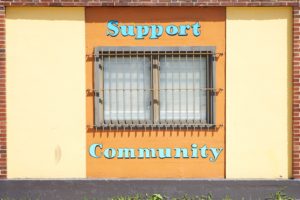Meet “Mercedes”
Mercedes drove two hours to the nearest healthcare clinic to get her first physical exam in ten years. I met Mercedes while shadowing primary care physician Dr. L. In the clinic, Mercedes divulged to me how nervous she had been driving in – she knew what the meeting held in store. Her fears were confirmed: just five minutes into her exam, Dr. L advised her, “Mercedes, you have to lose weight.”
Racial Disparities in Obesity
Mercedes is part of a national epidemic. As of 2016, 40% of Americans are obese.[i] When considering factors that impact an individual’s weight, the public and the media tend to focus on individual behavior such as diet and exercise.[ii] We may blame individuals like Mercedes, attributing their weight to laziness. “‘Try harder,’” Mercedes recounted to me in the clinic, is advice she often hears.
Is Individual Behavior to Blame?
However, this advice is inadequate. Though individual behavior plays a role, it cannot fully explain the striking disparity in the prevalence of obesity by race. Mercedes is a forty-six-year-old Black woman, and Black/African Americans disproportionately suffer the highest obesity rates – 48% among Black/African Americans compared to 43% among Latinos, 35% among whites, and 12% among Asians.[iii] This disparity is especially concerning now since obesity increases the risk of severe illness from COVID-19.[iv] The disproportionately high obesity rate among Black/African Americans stems from the broader issue of racism and its impact on the built environment, or the man-made aspects of where one lives.
Racism and the Built Environment
Mercedes spent months searching for safe, affordable housing in Alabama before settling for her two-bedroom house next to Highway 18. Beginning in the 1930s, the US government refused to grant Black/African Americans housing loans in a policy called redlining, forcing Black/African Americans into poorer neighborhoods.[v] Though redlining has long been banned, its impacts persist. Black/African Americans still form the majority of residents in redlined neighborhoods.[vi] Redlined neighborhoods generally lack access to fresh food, adequate green space, and larger hospitals.[vii] They face more pollution and violence. With two jobs, a long commute, and two kids, the only downtime Mercedes gets is an hour in the late evenings. However, with few street lights and constant traffic in her neighborhood, she does not feel safe walking outside at night which has greatly limited her physical activity.
Feeling Helpless
As a result of country-wide protests and increased awareness of the disproportionate burden of COVID-19 on racial and ethnic minority groups, more physicians are beginning to recognize the effects of race and racism on health.[viii] After Mercedes left the clinic that day, a quiet, low tone replaced Dr. L’s usually brassy voice as she talked through the situation with a colleague. Dr. L had felt helpless as she treated Mercedes for high blood pressure and diabetes but knew Mercedes was going back to the same environmental conditions that were causing her ailments.
A Physician’s Duty
Some may wonder, if racism is a structural, public health issue, is it a physician’s duty to address racism? A physician’s role is primarily to provide the highest quality health care to those in need. However, racial biases can affect the delivery of care, especially in emergency situations.[ix] Racism has profound impacts on health, and there are a multitude of ways for physicians to address it in meaningful ways without overburdening themselves. In fact, addressing racism can improve medical care.9 It can help physicians identify a possible root cause of the health-harming conditions, in which a patient may live, and can reduce physicians’ implicit racial biases, which have been shown to affect quality of care.[x]
Addressing Racism as Part of Medical School
Learning how to integrate practices to reduce racial bias and inequity is a process that should start as early as medical school – during hiring, admissions, and first-year training. During hiring and admissions, medical schools should aim for racial diversity among students, faculty, staff, and administration to help their affiliates meet people from different backgrounds, broaden their perspectives, and practice empathy. Most medical schools have an orientation week intended to introduce first-year students to different aspects of the school and for students to get to one another and the faculty, staff, and administration. Medical schools, including Boston University School of Medicine, Harvard School of Medicine, and Johns Hopkins School of Medicine, integrate a racial equity workshop into that orientation week for students to learn about racial disparities in medicine, share stories about their experiences with race, and get comfortable talking about racism.[xi],[xii],[xiii] Interventional studies show that these kinds of training and forums can help physicians better address racism, by promoting effective dialogues on racism, without requiring a significant time commitment.[xiv]
First-year Clinical Skills courses can also incorporate training on long-term, structural issues like racism. While learning history-taking, for example, medical students should be trained to screen for social factors by asking patients questions such as, “What do you do in your free time? Where do you shop for groceries? Do you feel safe in your neighborhood?” These were the kinds of questions that had helped Dr. L better understand Mercedes’ lifestyle and environment and had led Dr. L to identify racism as a possible risk factor for Mercedes’ health. These questions build trust and can open the door for further conversations about experiences with racism.
A First Step
The recommendation for physicians to learn about and address racism in a clinical setting is just the beginning. A physician’s role is to dig deeper into a patient’s history and to connect patients with other individuals and organizations. This first step will initiate communication with an interdisciplinary team, including dieticians, social workers, and organizations such as support groups. Dieticians are the most obviously applicable to Mercedes’ case. However, an interdisciplinary team is necessary to tackle health problems that are related to systemic issues, such as racism. Social workers can help identify unsafe aspects of Mercedes’ environment and relay this information to state organizations. Support groups can help Mercedes find community and provide safety in numbers. This multi-level cooperation can raise awareness about the effect of racism on health and mitigate racial disparities in social support and access to medical care.
Physicians’ Role on a Larger Scale
On a larger scale, a physician’s role is to use patient narratives to put a face to governmental issues. Mercedes’ case highlights several relevant issues: housing discrimination, universal healthcare, and federal funding for community health centers. Housing discrimination had forced Mercedes into health-harming conditions. Mercedes had postponed getting her physical and had to drive two hours that day because there was no other clinic nearby that accepted her insurance. Universal healthcare could have encouraged Mercedes to seek care earlier and more frequently. Similarly, increased funding for community health centers could help improve existing centers or open new centers in communities like Mercedes’.
Student groups, such as American Medical Association/Medical Student Section (AMA/MSS), can give medical students a platform to learn about and express their opinions on these issues. AMA is the largest organization of physicians (MDs and medical students) in the United States. Many medical schools have a student group that manages the AMA/MSS chapter at the school.[xv] AMA/MSS student and physician leaders teach newer medical students how to craft policy briefs. AMA/MSS offers the opportunity to attend policy-making conferences and vote on state and national issues. Student groups, such as AMA/MSS, can teach physicians to identify racist policies and to be advocates for their patients on a larger scale. Along with facts and statistics, physicians can share their personal feelings upon having to send patients, such as Mercedes, back to health-harming conditions and to counter those who blame the patients without acknowledging the broader factors at play. Addressing racism in this way can lead to hospital-, state- and national-level changes, but making a difference in the life of even just one individual like Mercedes is progress towards health equity.
[i] Arroyo-Johnson C, Mincey KD. Obesity epidemiology worldwide. Gastroenterol Clin North Am. 2016 Dec;45(4):571-579.
[ii] Bombak A. Obesity, health at every size, and public health policy. Am J Public Health. 2014 Feb;104(2):60-67.
[iii] Byrd AS, Toth AT, Stanford FC. Racial disparities in obesity treatment. Curr Obes Rep. 2018 Jun;7(2):130-138.
[iv] Centers for Disease Control and Prevention. People with certain medical conditions. 2020 Nov 2.
[v] National Public Radio. A ‘forgotten history’ of how the U.S. government segregated America. 2017 May 3.
[vi] Jan T. Redlining was banned 50 years ago. It’s still hurting minorities today. The Washington Post. 2018 Mar 28.
[vii] Jackson RJ, Kochtitzky C. Creating a healthy environment: the impact of the built environment on public health. Centers for Disease Control and Prevention.
[viii] Centers for Disease Control and Prevention. Health equity considerations and racial and ethnic minority groups. 2020 Jul 24.
[ix] Williams DR, Rucker TD. Understanding and addressing racial disparities in health care. Health Care Financ Rev. 2000;21(4):75-90.
[x] Hall WJ, Chapman MV, Lee KM, et al. Implicit Racial/Ethnic Bias Among Health Care Professionals and Its Influence on Health Care Outcomes: A Systematic Review. Am J Public Health. 2015;105(12):60-76.
[xi] Boston University. Diversity & inclusion.
[xii] Harvard Medical School. Diversity and inclusion. 2020.
[xiii] Johns Hopkins Medicine. Office of diversity, inclusion, and health equity.
[xiv] Hardeman RR, Burgess D, Murphy K. Developing a medical school curriculum on racism: multidisciplinary, multiracial conversations informed by public health critical race praxis (PHCRP ). Ethn Dis. 2018;28(1):271-278
[xv] American Medical Association. Medical student section (MSS).
- Racism in Medicine – What Physicians Can Do - January 5, 2021




